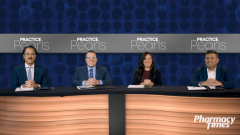
Hemophilia A Treatment Pathways: Acute versus Prophylaxis
Atta Chowdhry, RPh, discusses treatment approaches for acute episodes and prophylaxis in patients with hemophilia A.
Episodes in this series

Jonathan Ogurchak, PharmD, CSP: Talking across a lot of these patient types and things that we’ve mentioned here, you see the need for acute treatment, obviously, but then there’s also that possibility of prophylaxis just to help to reduce the possibility of bleeds. Now, Dr Chowdhry, what do you tend to see when you’re looking at treatment pathways for those acute episodes as opposed to more prophylaxis types of use?
Atta Chowdhry, RPh: For acute episodes, we are still using a common factor, that’s the standard from MASAC [Medical and Scientific Advisory Council] guideline. The dosage usually is 50 u/kg, and that covers you, basically 80% to 100% of your factor, need to bring you up to the factor level of between 80% to 100%. Then the therapy depends on the type of the bleed and what’s the response on that patient. That’s a standard for acute bleed that it’s still anything for any kind of acute bleed, the factor, recombinant factor is still the standard.
Jonathan Ogurchak, PharmD, CSP: How about for the prophylaxis type of treatment?
Atta Chowdhry, RPh: Prophylaxis is the 1 that if you are a severe hemophiliac and you have less than 1% factor in your body, then definitely that patient requires to be on a prophylactic treatment. Because in the long run, you want to prevent joint damage, you want to have no severe bleeds, intracranial bleed, or any kidney bleed or ileitis bleed, or any of those kind of bleeds, you want to try to avoid that. At this point, as Dr Sidonio mentioned, the gold standard is emicizumab. A lot of these patients, depending on the activity level, as Dr Sidonio mentioned, that if you are a very active person and you want to know your factor level, then definitely you want to be on a factor product. But if you are a kid who is playing video games or at home and going to school, then definitely you want to be on emicizumab. In my practice I’ve seen that patients do very well on it. They tend to stay on that product. I have not seen a single patient in my practice who was on emicizumab and went back to the factor level. But if you have any kind of bleed, then at that time we have treated them with a regular factor.
Jonathan Ogurchak, PharmD, CSP: That was going to be my next question. We talked about those 2 scenarios. What about, are you seeing any use in combination of this?
Atta Chowdhry, RPh: Yes, so combination definitely is there because emicizumab is only there to prevent the bleeding. Bleeding is not there to stop the bleed. In order to stop the bleed, you have to use a factor. The standard is usually that the patient is on emicizumab. They get on a loading dose during the loading dose period, they do infuse factor just in case. After, once they are on prophylactic, they keep 4 to 5 doses on hand, just in case there is any kind of trauma or any other issues, then they can immediately get to the infusion. The only drawback is that a lot of the younger kids are coming up with the grownup with emicizumab. Now it’s out there 4 years or plus. Those kids, because they have not done a lot of infusions, it’s hard for the parents to do the infusions for those kids. You have to take them to the emergency [department] with the product so you can get somebody to infuse the product to that patient.
Transcript is AI generated and reviewed by a Pharmacy Times editor.
Newsletter
Stay informed on drug updates, treatment guidelines, and pharmacy practice trends—subscribe to Pharmacy Times for weekly clinical insights.









































































































































































































